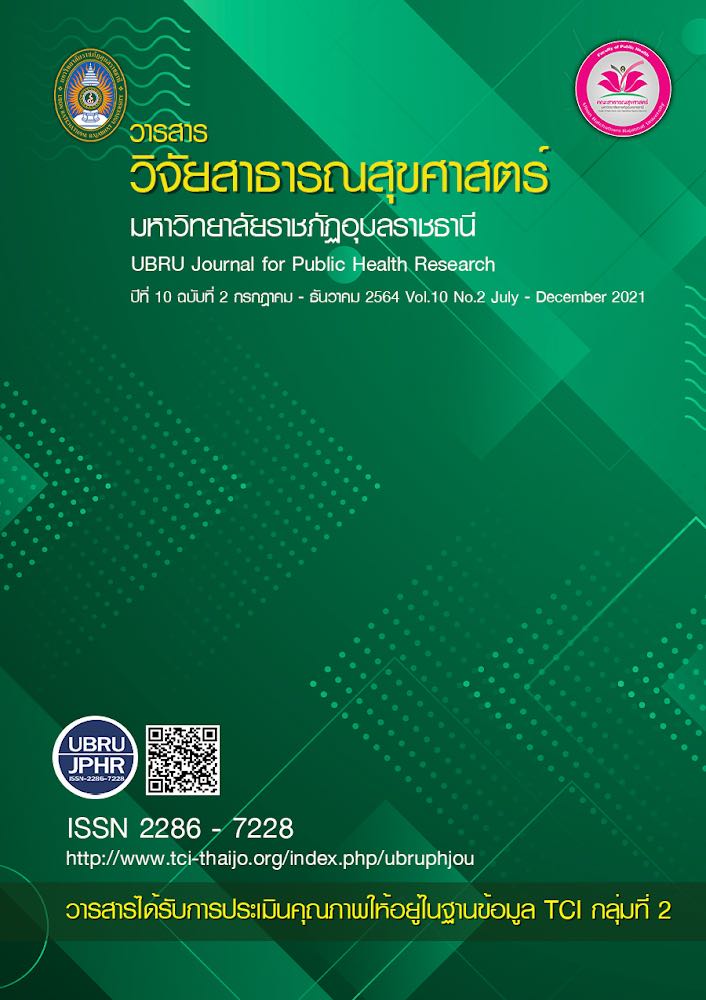Factors associated with helmet wearing among students in Rajabhat Maha Sarakham University
Keywords:
Helmet wearing condition, helmet, studentsAbstract
The objectives of this research were to investigate the helmet wearing condition among students in Rajabhat Maha Sarakham University and to study factors associated with helmet wearing condition among students in Rajabhat Maha Sarakham University. The population was 11,909 students in Rajabhat Maha Sarakham University. The sample size was 392 people, obtained by a multistage sampling. Data were collected by a questionnaire. The study period was from October 2019 to March 2020. Data were analyzed using descriptive statistics, including percentage, mean, standard deviation as well as inferential statistics, namely Pearson's Correlation Coefficient Statistics.
The results of the research revealed that the sample’s knowledge about helmet wearing knowledge was at a moderate level with a mean of 7.66 (S.D. = 1.48). The sample’s attitude toward helmet use was at a moderate level with a mean of 2.15 (S.D. = 0.50). The sample’s perception on helmet wearing was at a good level with a mean of 2.69 (SD = 0.46). Helmet wearing frequency was at the regular level with a mean of 2.59 (SD = 0.49). Social factor was at sometimes level with a mean of 2.26 (SD = 0.50). The results of studying helmet wearing condition among the sample showed that attitude, perception, and social factors were associated with helmet wearing condition with a statistical significance level of 0.05.
Therefore, to build systematic approaches to promotion and development, constant helmet wearing campaign should be promoted to achieve safe driving with an emphasis on participation of administrators, lecturers, and students. For example, activities should be created together; rules and regulations should be formulated universally, resulting in helmet wearing rate reaching 100% and reduction of accidents.
References
กองพัฒนากิจการนักศึกษามหาวิทยาลัยราชภัฏมหาสารคาม, (2562) [ออนไลน์]. สืบค้นเมื่อ 11 กุมภาพันธ์ 2562 จาก : http://std.rmu.ac.th/page/
กาญจน์กรอง สุอังคะ (2559) พฤติกรรมการขับขี่ของวัยรุ่นที่มีผลต่อความเสี่ยงในการเกิดอุบัติเหตุ จากการใช้รถจักรยานยนต์การคัดเลือกพื้นที่ที่ศึกษา. นครราชสีมา : คลังปัญญา มหาวิทยาลัยเทคโนโลยีสุรนารี.
ณัฐบดี วิริยาวัฒน์ และ สุรชาติ สินวรณ์ (2556) ปัจจัยที่มีผลต่อการใช้หมวกนิรภัยในการป้องกัน อุบัติเหตุของนักศึกษามหาวิทยาลัยราชภัฏสวนดุสิต. Research Journal Sciences and Technology, 5 (2): 83 - 85.
บุปผา ลาภทวี. (2555) ปัจจัยที่มีความสัมพันธ์ต่อพฤติกรรมการสวมหมวกนิรภัยของผู้บาดเจ็บจากการขับขี่รถจักรยานยนต์ โรงพยาบาลธรรมศาสตร์เฉลิมพระเกียรติ. โรงพยาบาลธรรมศาสตร์เฉลิมพระเกียรติ.
วัฒนวงศ์ รัตนวราห, และคณะ (2557) ศึกษาและพัฒนาการวิเคราะห์รูปแบบปัจจัยที่มีผลต่อพฤติกรรมการสวมหมวกนิรภัยโดยใช้สมการโครงสร้างบนพื้นฐาน ทฤษฎีแบบแผนความเชื่อด้านสุขภาพ. มหาวิทยาลัยเทคโนโลยีสุรนารี.
ศูนย์ข้อมูลอุบัติเหตุเพื่อเสริมสร้างวัฒนธรรมความปลอดภัยทางถนน. (2562) ทศวรรษแห่งความปลอดภัยทางถนน. [ออนไลน์]. สืบค้นเมื่อ 26 มกราคม 2562 จาก : http://www.thairsc.com/
สำนักงานกองทุนสนับสนุนการสร้างเสริมสุขภาพ. (2562) [ออนไลน์]. สืบค้นเมื่อ 1 กุมภาพันธ์ 2562 จาก : https://www.thaihealth.or.th/
หน่วยเฝ้าระวังและสะท้อนสถานการณ์ความปลอดภัยทางถนน. (2562) [ออนไลน์]. สืบค้นเมื่อ 26 มกราคม 2562 จาก : http://trso.thairoads.org/
อรุณ จิรวัฒน์กุล. (2547) ชีวสถิติสำหรับงานวิจัยทางวิทยาศาสตร์สุขภาพ. ขอนแก่น : ภาควิชาชีวสถิติและประชากรศาสตร์ คณะสาธารณสุขศาสตร์ มหาวิทยาลัยขอนแก่น.
Downloads
Published
How to Cite
Issue
Section
License
เนื้อหาและข้อมูลในบทความที่ลงตีพิมพ์ในวารสารวารสารวิจัยสาธารณสุขศาสตร์ มหาวิทยาลัยราชภัฏอุบลราชธานี ถือเป็นข้อคิดเห็นและความรับผิดชอบของผู้เขียนบทความโดยตรงซึ่งกองบรรณาธิการวารสาร ไม่จำเป็นต้องเห็นด้วย หรือร่วมรับผิดชอบใดๆ
บทความ ข้อมูล เนื้อหา รูปภาพ ฯลฯ ที่ได้รับการตีพิมพ์ในวารสารนี้ ถือเป็นลิขสิทธิ์ของวารสารฯ หากบุคคลหรือหน่วยงานใดต้องการนำทั้งหมดหรือส่วนหนึ่งส่วนใดไปเผยแพร่ต่อหรือเพื่อกระทำการใดๆ จะต้องได้รับอนุญาตเป็นลายลักอักษรณ์จากบรรณาธิการวารสารนี้ก่อนเท่านั้น


